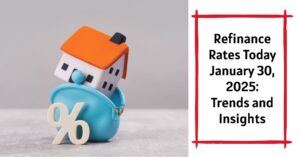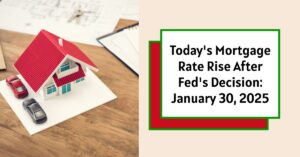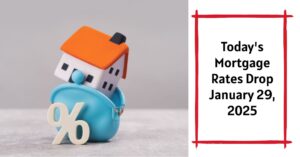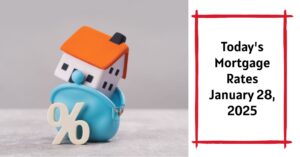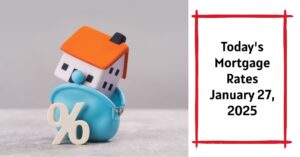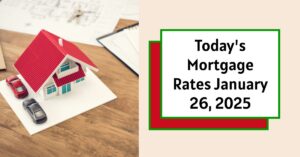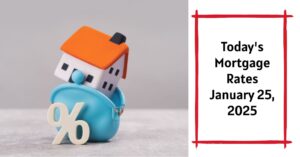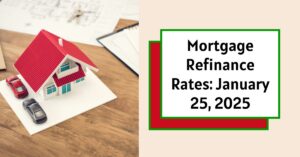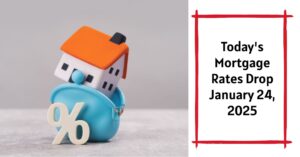If you're pondering the question of “refinance rates today – January 30, 2025,” you've come to the right place. Today's average refinance rates for a 30-year fixed mortgage stand at 7.02%, reflecting a 10 basis point decrease from last week. This insight is crucial, especially if you're considering refinancing your mortgage to benefit from potentially lower payments.
Refinance Rates Today January 30, 2025: Trends and Insights
Key Takeaways
- Current 30-Year Fixed Mortgage Refinance Rate: 7.02%
- Decrease from Last Week: -0.10%
- Average Monthly Payment: $666.65 per $100,000 borrowed
- Factors Affecting Rates: Inflation, Federal Reserve actions, and geopolitical events
- Expert Insight: Mortgage rates expected to stay in the 6% range for most of 2025
With the fluctuations in the market over the past months, many homeowners are seeking opportunities to lower their mortgage payments through refinancing. As we delve deeper into the current rates and underlying factors, it's essential to understand how these changes could impact your financial decisions.
Current Refinance Rates: A Close Look
As of January 30, 2025, here are the current mortgage refinance rates, according to Bankrate:
| Mortgage Type | Today's Rate | Change from Last Week |
|---|---|---|
| 30-Year Fixed | 7.02% | -0.10% |
| 15-Year Fixed | 6.26% | -0.10% |
| 5/1 ARM | 6.30% | +0.01% |
| 30-Year Fixed Jumbo | 6.96% | -0.06% |
These rates reflect average figures compiled by Bankrate based on consumer borrowing patterns and lender offerings.
Mortgage Type Trends
30-Year Fixed Refinance Rates
The 30-year fixed refinance rate has decreased to 7.02%, down from 7.12% last week. At this rate, if you borrow $100,000, your estimated monthly payment will be approximately $666.65, which is a saving of $6.73 compared to the previous week. This type of loan remains popular due to its predictability and long-term stability.
15-Year Fixed Refinance Rates
The 15-year average fixed refinance rate is currently at 6.26%, down 10 basis points from last week's 6.36%. This rate provides a quicker path to owning your home outright but comes with higher monthly payments. For a loan of $100,000, expect your monthly payment to be around $858. Many homeowners choose this option if they can afford higher payments and want to save on interest overall.
5/1 Adjustable Rate Mortgage (ARM)
Today, the 5/1 ARM has seen a slight uptick to 6.30%, which is an increase of 1 basis point from last week. This type of mortgage offers lower initial rates but comes with the risk of fluctuating payments after the introductory period ends. By locking in a 5/1 ARM, borrowers can take advantage of lower initial rates, which often make this option appealing for those who anticipate moving or refinancing again within a few years.
Jumbo Loan Rates
Jumbo loans, which are used for financing properties above conforming loan limits, have also seen a reduction in rates. Currently, the average jumbo loan rate is 6.96%, down from 7.02% last week. Borrowers will pay around $662.62 a month for every $100,000 borrowed. Jumbo loans can be more complex due to their size, and market conditions can greatly influence rates, emphasizing the importance of working with knowledgeable lenders.
What Influences Refinance Rates?
Several factors lead to changes in refinance rates. Understanding these can provide insight into why rates fluctuate:
- Federal Reserve Decisions: Recently, the Federal Reserve's adjustments to its key benchmark rate were crucial. The Fed's decisions influence interest rates and directly affect monthly payments for homeowners. Though mortgage rates didn’t drop as expected after recent rate cuts, it’s crucial to anticipate how future Fed policy may affect borrowing costs.
- Inflationary Pressures: High inflation can soar mortgage rates. As consumer prices increase, lenders adjust their rates to mitigate risk. Current inflation trends have led many lenders to be cautious when setting their rates, directly impacting current mortgage offerings.
- Economic Indicators: The condition of the job market, consumer spending, and overall economic growth significantly influence mortgage lending rates. Healthy economic indicators often lead to higher rates. Conversely, signs of economic slowdown may prompt lenders to offer lower rates as they compete for fewer customers.
- Geopolitical Events: Events that shake global markets can cause uncertainty, pushing investors toward safer assets like U.S. Treasury bonds. Such shifts affect mortgage rates as they usually track these bond yields. Recent geopolitical tensions and uncertainties have influenced financial markets, leading to fluctuations in refinancing options.
Looking Ahead: What to Expect for 2025
According to Greg McBride, CFA, chief financial analyst for Bankrate, mortgage rates are projected to remain stable in the low to mid-6 percent range throughout 2025. Homeowners with current rates below this range may not find significant benefits in refinancing.
Future Rate Projections
Here are some expert predictions regarding mortgage rates:
- The 30-year fixed mortgage rate could frequently occupy the 6% territory with occasional spikes above 7%.
- A continuous decline beneath 6% might not be expected, indicating that those with rates around this figure might maintain their existing loans.
The Impact of Refinancing in Today’s Market
Many homeowners often grapple with whether refinancing their existing mortgages is wise, given these rates. As 84% of mortgage debt is priced at 6% or below, the market's current landscape provides both opportunities and challenges.
One major factor to consider is the potential of even minor rate declines affecting your decision. For example, as rates dipped to the low 6s last fall, many homeowners capitalized on refinancing options, leading to the processing of over 300,000 loan applications in a short time. This indicates an active market where homeowners are keen to adjust their financial strategies when faced with advantageous rates.
Understanding the Long-Term Diligence in Refinance Decisions
While it can be tempting to jump on the chance to refinance when rates dip slightly, personal circumstances play a critical role. Homeowners must consider various factors including:
- Length of Stay: If you plan to stay in your home for a significant time, refinancing can save you money over the life of the loan.
- Current Equity: Your equity position can affect refinancing eligibility and the rates you'll receive.
- Cost of Refinancing: Closing costs and fees need to be factored into the equation; sometimes it can take years to recoup these costs through lower payments.
Snapshot of Current Market Conditions
| Factor | Impact on Rates |
|---|---|
| Federal Reserve Policy | Direct influence on benchmark rates |
| Inflation Trends | Upward pressure on loan costs |
| Economic Performance | Volatile effects on consumer rates |
| Global Events | Cause shifts in investor confidence |
General Market Trends and Predictions for 2025
Mortgage rates are being closely monitored by economic analysts and homeowners alike, given the intertwining dynamics of economics and personal finance. Predictions indicate a possibility of an overall stable mortgage environment, with occasional fluctuations.
- Expert Predictions: Industry experts suggest keeping a watchful eye on labor market reports and inflation updates throughout 2025. Such reports are pivotal in shaping Federal Reserve policy and, in turn, the interest rates lenders offer.
- The Effect of Election Cycles: The political landscape can also play a crucial role in economic sentiment. As the nation gears up for elections, shifts in administration can lead to different fiscal policies that inherently affect mortgage rates.
Summary:
Today's refinance rates indicate a transitional period as homeowners assess opportunities to save money through lower monthly payments. As the landscape shifts, staying informed on current rates and future projections will be crucial for any homeowner considering refinancing their mortgage.
Work with Norada, Your Trusted Source for
Turnkey Rental Properties
Discover high-quality, ready-to-rent properties designed to deliver consistent returns.
Contact us today to expand your real estate portfolio with confidence.
Contact our investment counselors (No Obligation):
(800) 611-3060
Recommended Read:
- Best Time to Refinance Your Mortgage: Expert Insights
- Should I Refinance My Mortgage Now or Wait Until 2025?
- When You Refinance a Mortgage Do the 30 Years Start Over?
- Should You Refinance as Mortgage Rates Reach Lowest Level in Over a Year?
- NAR Predicts 6% Mortgage Rates in 2025 Will Boost Housing Market
- Mortgage Rates Predictions for 2025: Expert Forecast
- Half of Recent Home Buyers Got Mortgage Rates Below 5%
- Mortgage Rates Need to Drop by 2% Before Buying Spree Begins
- Will Mortgage Rates Ever Be 3% Again: Future Outlook
- Mortgage Rates Predictions for Next 2 Years
- Mortgage Rate Predictions for Next 5 Years
